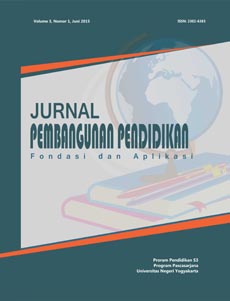Persepsi mahasiswa calon guru terhadap penggunaan Phet Colorado untuk memfasilitasi kemampuan representasi visual
DOI:
https://doi.org/10.21831/jppfa.v7i2.26312Keywords:
Kemampuan representasi visual, phet, e-learning, visual representation abilityAbstract
Penelitian ini bertujuan untuk mengetahui presepsi mahasiswa calon guru fisika terhadap penggunaan PhET Colorado dalam memfasilitasi kemampuan representasi visual mereka dalam pembalajaran fisika. Adapun jenis penelitian ini merupakan penelitian deskriptif dengan menggunakan pendekatan kualitatif. Subyek penelitian merupakan mahasiswa magister pendidikan fisika Universitas Negeri Yogyakarta semester pertama tahun ajaran 2017/2018. Hasil penelitian dari 20 responden menunjukkan bahwa 50% responden sangat tertarik menggunakan PhET Colorado, dengan persepsi mahasiswa terhadap kemampuan representasi visual menggunakan PhET Colorado sebesar 85%, penggunaan PhET Colorado dianggap siswa mampu memfasilitasi kemampuan representasi visual mereka dalam pembelajaran fisika.
Abstract
The demands of 21st century skills highlighted the importance of cooperation between teachers and students to achieve the expected skill. Pedagogical knowledge of teachers in teaching and technology into things that need to be developed. Pedagogic ability of teachers in the use of technology can be a potential to develop students' abilities argument. This study aims to develop students' ability argumentation through pedagogical knowledge of teachers in using technology. The technology used is the result of the development of student worksheets 3D PageFlipp Impulse and Momentum material. The purpose of this study to look at the ability of students through the application of scientific argumentation (Technological Pedagogic Knowledge) TPK teachers in the classroom. This research is descriptive research. The data collection capability student argumentation performed by administering a written test. The subjects were students of class X at SMAN 1 Yogyakarta Prambanan. Rate scientific argumentation ability of students refers to Toulmin Argumentation Pattern (TAP). The results showed that the complexity of argumentation ability of students still at low level . These results suggest that the ability of the student arguments need to be improved.
References
Ainsworth, S. E., Prain, V., & Tytler, R. 2011. Drawing to learn in science. Science. Journal of Science Education: 333 (6046), pp. 1096-1097. DOI: http://dx.doi.org10.1126/science.1204153
Ainsworth, Shaaron. 2006. "A Conceptual Framework For Considering Learning With Multiple Representations". School of Psychology and Learning Sciences Research Institute. University of Nottingham: vol 183-198
Cromley, Jennifer G., Snyder-Hogan Lindsey E., Luciw-Dubas, Ulana A. 2010. Cognitive activities in complex science text and diagrams. Contemporary Educational Psychology, 35 (1), pp. 59-74. DOI: http://dx.doi.org10.1016/j.cedpsych.2009.10.002
Czuchry, M., Dianna, N. M., & Donald, F.D. 2009. Visual Representation Tools for Improving Addiction Treatment Outcomes. Journal of Psychoactive Drugs, 41 (2), pp. 181-187. DOI: http://dx.doi.org10.1080/02791072.2009.10399911
Fasko, D. 2015. An analysis of multiple intelligences theory and its use with the gifted and talented. International Roeper Review, 23 (3), pp. 126-130. DOI: http://dx.doi.org10.1080/02783190109554083
Goodnough, K. 2010. Implementing multiple intelligences theory in a grade 9 science classroom: The experiences of a high school teacher. Canadian Journal of Science, Mathematics and Technology Education, 1 (4), pp. 419-436. DOI: http://dx.doi.org10.1080/14926150109556483
Gunawan, Adi W. 2007. Genius Learning Strategy. Jakarta: Gramedia Pustaka Utama
Hubber, P., Tytler, R., Haslam, F. 2010. Teaching and learning about force with a representational focus: Pedagogy and teacher change. Research in Science Education, 40 (1), pp. 5-28. DOI: http://dx.doi.org10.1007/s11165-009-9154-9
Ismet. 2013. Pengembangan Program Perkuliahan Mekanika Berbasis Multiple Representations Untuk Meningkatkan Kecerdasan Spasial (Spatial Intelligence) Mahasiswa Calon Guru. Disertasi. Bandung: Universitas Pendidikan Indonesia
Kaheru, S.J., & Kriek, J. 2016. The Effect of Computer Simulations on Acquisition of Knowledge and Cognitive Load: A Gender Perspective. African Journal of Research in Mathematics, Science and Technology Education, 20 (1), pp. 67-79. DOI: http://dx.doi.org10.1080
/10288457.2016.1150558
Kartini. 2009. Peranan Representasi Dalam Pembelajaran Matematika.Jurnal. Pekanbaru: ISBN : 978-979-16353-3-2 (P22)
Lancaster, K., Moore, E.B., Parson, R., Perkins, K.K. 2013. Insights from using PhET's design principles for interactive chemistry simulations. ACS Symposium Series, 1142, pp. 97-126. DOI: http://dx.doi.org10.1021/bk-2013-1142.ch005
Nitz, S., Prechtl, H., Nerdel, C. 2014. Survey of classroom use of representations: development, field test and multilevel analysis. Learning Environments Research, 17 (3), pp. 401-422. DOI: http://dx.doi.org10.1007/s10984-014-9166-x
Paklone, I. 2012. Conceptualization of visual representation in urban planning. Limes: Borderland Studies, 4 (2), pp. 150-161. DOI: http://dx.doi.org10.3846/20290187.2011.631046
Perkins, K., Adams, W., Dubson, M., Finkelstein, N., Reid, S., Wieman, C., Le Master, R. 2006. PhET: Interactive simulations for teaching and learning physics. Physics Teacher, 44 (1), pp. 18-23. DOI: http://dx.doi.org10.1119/1.2150754
Perkins, K., Moore, E., Podolefsky, N., Lancaster, K., Denison, C. 2012. Towards research-based strategies for using PhET simulations in middle school physical science classes. AIP Conference Proceedings, 1413, pp. 295-298.
Rau, M.A. 2016. Conditions for the Effectiveness of Multiple Visual Representations in Enhancing STEM Learning. Educational Psychology Review, pp. 1-45. DOI: http://dx.doi.org10.1007/s10648-016-9365-3
Rau, M.A., Aleven, V., Rummel, N. 2015. Successful learning with multiple graphical representations and self-explanation prompts. Journal of Educational Psychology, 107 (1), pp. 30-46. DOI: http://dx.doi.org10.1037/a0037211
Rau, M.A., Aleven, V., Rummel, N., Pardos, Z. 2014. How should intelligent tutoring systems sequence multiple graphical representations of fractions? A multi-methods study. International Journal of Artificial Intelligence in Education, 24 (2), pp. 125-161. DOI: http://dx.doi.org10.1007/s40593-013-0011-7
Rau, M.A., Bowman, H.E., Moore, J.W. 2017. An adaptive collaboration script for learning with multiple visual representations in chemistry. Computers and Education, 109, pp. 38-55. DOI: http://dx.doi.org10.1016/j.compedu.2017.02.006
Rau, M.A., Matthews, P.G. 2017. How to make "˜more' better? Principles for effective use of multiple representations to enhance students' learning about fractions ZDM. Mathematics Education, 49 (4), pp. 531-544. DOI: http://dx.doi.org10.1007/s11858-017-0846-8
Reiner, M. 2009. Sensory Cues, Visualization and Physics Learning. International Journal of Science Education, 31 (3), pp. 343-364. DOI: http://dx.doi.org10.1080/09500690802595789
Reiner, M. 2012. Thought experiments and collaborative learning in physics. International Journal of Science Education, 20 (9), pp. 1043-1058. DOI: http://dx.doi.org10.1080/0950069980200903
Sutopo, Waldrip, B. 2014. Impact Of A Representational Approach On Students' Reasoning And Conceptual Understanding In Learning Mechanics International Journal of Science and Mathematics Education, 12 (4), pp. 741-765. DOI: http://dx.doi.org10.1007/s10763-013-9431-y
Wahyuni, S., Marwan A.R., & Susana. 2016. Persepsi Siswa Terhadap Penggunaan Media Pembelajaran Fisika di SMA Negeri Se-Kota Banda ACEH. Jurnal Ilmiah Mahasiswa (JIM) Pendidikan Fisika, 2 (1), pp. 135-140.
Waldrip, B., Prain, V., Sellings, P. 2013. Explaining Newton's laws of motion: Using student reasoning through representations to develop conceptual understanding. Instructional Science, 41 (1), pp. 165-189. DOI: http://dx.doi.org10.1007/s11251-012-9223-8
Wieman, C.E., Adams, W.K., Loeblein, P., Perkins, K.K. Teaching physics using PhET simulations. Physics Teacher, 48 (4), pp. 225-227. DOI: http://dx.doi.org10.1119/1.3361987
Wu, H.-K., Lin, Y.-F., Hsu, Y.-S. 2013. Effects of representation sequences and spatial ability on students' scientific understandings about the mechanism of breathing. Instructional Science, 41 (3), pp. 555-573. DOI: http://dx.doi.org10.1007/s11251-012-9244-3
Published
How to Cite
Issue
Section
Citation Check
License
The Authors submitting a manuscript do so on the understanding that if accepted for publication, copyright publishing of the article shall be assigned to Jurnal Pembangunan Pendidikan: Fondasi dan Aplikasi
 | Jurnal Pembangunan Pendidikan: Fondasi dan Aplikasi by https://journal.uny.ac.id/index.php/jppfa is licensed under a Creative Commons Attribution-ShareAlike 4.0 International License. |













